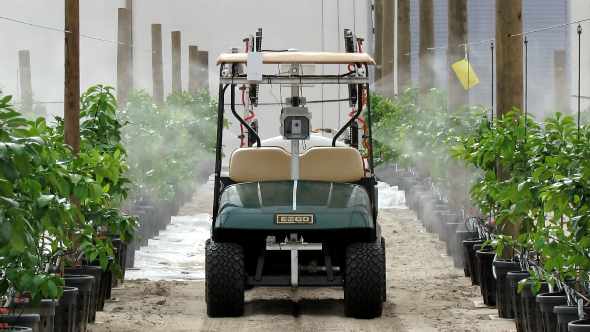Interest Continues To Grow In Protected Citriculture

Perhaps our earliest exposure to citrus production under cover was in Japan. More than a decade ago, Japanese citrus farmers began moving mandarin acreage into high-tech greenhouse structures. The focus of the Japanese program was greater control of growing conditions (temperature, light, inputs, water, etc.) to ensure production of high-quality, blemish-free citrus. Thanks to consumer preference and unique market forces, Japan has achieved its goal. The citrus from these operations commands a premium in the marketplace and the higher cost of production was justified.

Working inside structures, some manual caretaking activities can almost be completely eliminated.
Photo courtesy of UF/IFAS
Intrigued by the Japanese model, some Florida growers studied the possibility of using similar, but lower cost structures in Florida to produce blemish-free fruit for the fresh market. At that time (2007-2008), the economics didn’t seem to make sense and growers never moved forward.
Jump ahead to 2015. The goal of citrus production under screen has transitioned from an exclusive focus on external quality and grade, to the achievement of an Asian citrus psyllid (ACP)-free environment. Growers are weighing the benefits of HLB-free trees grown in a high-density setting, in a high-cost structure against the increasingly high cost of conventional production. Of course, the elimination of HLB from the equation increases quality, eliminates drop, and may lower input requirements.
UF/IFAS has done some excellent research on this issue (called Citrus Undercover Production Systems, or CUPS), and efforts are ongoing at both the CREC and IRREC.
The work of Dr. Arnold Schumann, Dr. Barrett Gruber, and Dr. Brian Boman has inspired several citrus growers to move this concept from research to reality. Two such operations are located in the Alturas area: Citrific and KLM Farms. I reached out to the UF/IFAS team and the owner/managers of the two Alturas operations for insight into this exciting effort.
Growers continue to seek input and guidance from UF/IFAS researchers on this issue, indicating an expanding interest in the possibilities. Gruber and Schumann addressed some common questions about CUPS.
Q: What is the average cost of construction for the pole and cable structures used for CUPS?
A: The structures that we have been working with are very customizable and, therefore, the cost per acre will depend greatly upon how the grower designs it, and what type of additions that they will include. For the design used at the IRREC site, and for a structure less than one acre in size, the expected cost will be in the neighborhood of about $2 per square foot. A 10-acre structure of the same design would cost less than $1 per square foot. So, buying in bulk has its advantages. The economy of scale is much more beneficial as the area of the proposed structure increases. Other factors that might noticeably affect the price per acre will be the height of the structure and the type of doorways and entryways that are installed. It is challenging to give a single price point because ultimately it will depend upon how the grower designs each structure. This is very much like constructing a residential home — the final price will be dictated by the types of features each individual chooses to include.
Q: It appears that there will be a great deal of manual pruning and hand work in these structures. What is a typical production cost/acre?
A: There doesn’t have to be a great deal of manual pruning. A bar hedger mounted on an ATV might be a good option for pruning quickly. In any event, we are planning a strategy for limited pruning of branches only smaller than about an eighth of an inch, anything bigger will stay. Over-pruning will lead to excessive vegetative growth, which we want to avoid. Pruning should be a targeted and precise activity. Thus, spending an inordinate amount of time and labor on pruning over the course of the year might indicate an over-zealous pruning program.
Working inside the structures, there will be other activities that can almost be completely eliminated. For example, herbicide application should be almost eliminated altogether. Good preparation in constructing the houses with a pre-establishment application of herbicide, with the possible use of ground cloth, will go a long way in preventing significant weed growth inside the structures. At the IRREC site, we applied a post-emergent herbicide within the footprint of each structure immediately after construction was completed and right before trees were established. Since then, we have not had to apply any herbicides inside the screen enclosures.
After construction of the houses, we anticipate the annual care-taking costs to be no greater than a conventional grove.
Managing annual caretaking costs should be considered in the initial planning and development of screenhouse construction. The pruning example is a good one. If that activity is considered to be an important one, adequate space inside the screenhouses should be allocated for any type of potential equipment that will need to be purchased.
Q: Does the structure provide any level of enhanced cold protection?
A: Both maximum and minimum air temperatures throughout the year are greater inside the screenhouses, compared to outside. However, we have not yet experienced a severe cold (less than 25°F) event at the IRREC site with the structures in place.
Q: Are you hearing from other growers interested in this concept?
A: Yes, we are getting regular visits by growers interested to see the concept of protected citriculture for themselves. The largest acreage being contemplated at this time is 40 to 100 acres, but it is in the very early planning stage.
Q: If a bactericide or antibiotic comes along that improves traditional outdoor production, is this system still viable — considering it produces higher grade fruit and it can be done with fewer inputs?
A: Aside from preventing ACP colonization, the protective screenhouses offer a number of other potential benefits. For one, they should not necessarily be dependent upon areawide insecticide applications and thus do not necessarily require coordination of multiple growers over large distances.
The protected screenhouse approach will remain significant and relevant in the event that the psyllid and CLas bacterium ever become resistant to insecticides and antibiotics, respectively.
We also have observed that the size of mesh screen that we are using also is effective in excluding citrus leafminer adults, which might have important implications in managing canker as well.
Perhaps the ultimate goal that might be considered is to grow commercially-viable, premium organically-labeled fresh citrus. This will not be possible with conventional insecticides and perhaps some future antibiotics. Using protected structures to cultivate fresh citrus might put large-scale, organically-labeled fruit production within grasp.
We also are observing improved plant water-use efficiency inside the protective screenhouses. Trees grown inside develop more canopy with less irrigation compared to trees grown outside.
These potential water savings should be an attractive benefit to growers in areas where water supply (the current record-breaking drought in California is the most relevant example) and responsible stewardship are a concern, and this should help benefit the bottom line of any business.
Q: Are you seeing better performance with trees in the ground vs. container?
A: One of the reasons for investigating containerized production was the potential ability of the pot to limit the tree size. Overall, what we have observed so far, they are doing just that. Trees grown in-ground have grown much larger in the same amount of time compared to the containerized trees. Thus, the decision to use one method over the other will be based on the individual grower’s cultivation program and goals, and the scion and rootstock combination also will likely affect the tree’s growth rate.
Q: Does this look viable with oranges and grapefruit, or only very high value specialty citrus?
A: At this time, this strategy is likely not appropriate for cultivating fruit pre-destined for processing/juicing.
Q: What is the wind rating of these structures?
A: We have observed 30 mph to 35 mph wind gusts at the IRREC site in Ft. Pierce and the structures hold up fine. Similar types of structures in Florida have not yet failed due to (non-hurricane) wind stress alone. However, to the best of our knowledge, they are not officially engineered-stamped for a particular wind load.
Final Thoughts
Sometimes, pioneers change the world. Sometimes they are the ones with the arrows in their backs. One thing is for certain, these are innovative and intelligent farmers who are doing their homework and striking out into uncharted territory. Sometimes risk produces great reward. The research community will continue their exploration of the same issues. It will be fascinating to see this move forward.
The CUPS research was funded by an SCRI block grant through FDACS, and the UF/IFAS Citrus Initiative.
Special appreciation to Dr. Barrett Gruber and Dr. Arnold Schumann for their contributions.










